Lyons W.C. (ed.). Standard handbook of petroleum and natural gas engineering.2001- Volume 1
Подождите немного. Документ загружается.

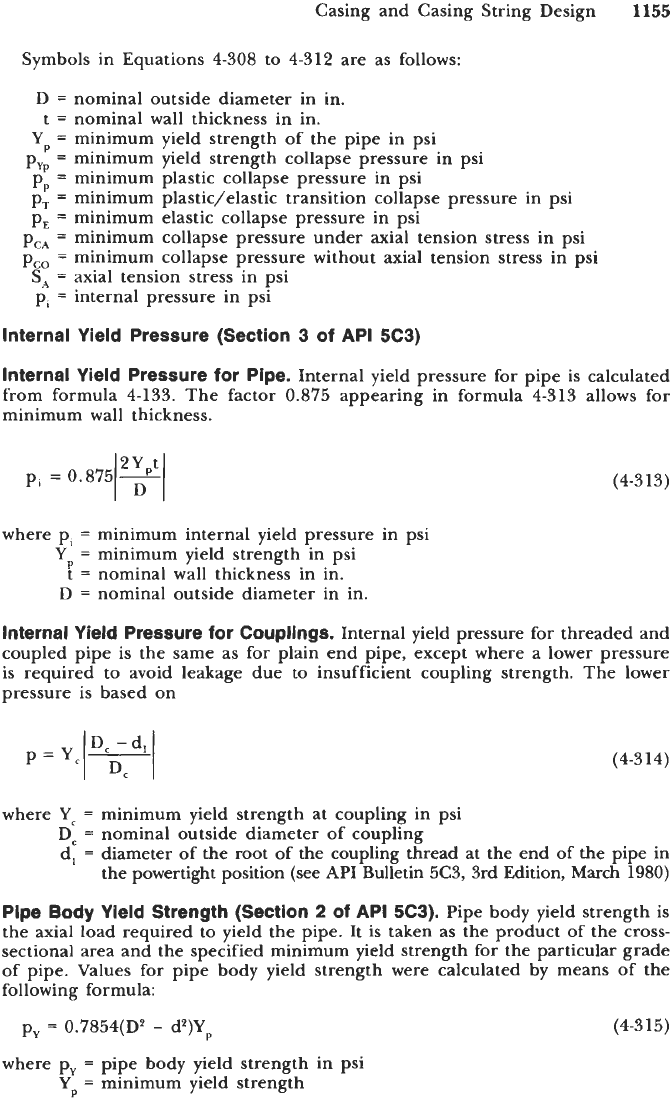
Casing and Casing String Design
1155
Symbols in Equations 4-308 to 4-312 are as follows:
D
=
nominal outside diameter in in.
Yp
=
minimum yield strength
of
the pipe in psi
3
=
minimum plastic collapse pressure in psi
pT
=
minimum plastic/elastic transition collapse pressure in psi
pE
=
minimum elastic collapse pressure in psi
pca
=
minimum collapse pressure under axial tension stress in psi
pco
=
minimum collapse pressure without axial tension stress in psi
t
=
nominal wall thickness in in.
=
minimum yield strength collapse pressure in psi
SA
=
axial tension stress in psi
pi
=
internal pressure in psi
Internal Yield Pressure (Section
3
of
API
5C3)
Internal Yield Pressure for Pipe.
Internal yield pressure for pipe is calculated
from formula 4-133. The factor
0.875
appearing in formula 4-313 allows for
minimum wall thickness.
pi
=
0.875/~/ 2Y,t
(4-3
13)
where pi
=
minimum internal yield pressure in psi
Yp
=
minimum yield strength in psi
t
=
nominal wall thickness in in.
D
=
nominal outside diameter in in.
Internal Yield Pressure for Couplings.
Internal yield pressure for threaded and
coupled pipe is the same as for plain end pipe, except where a lower pressure
is required to avoid leakage due to insufficient coupling strength. The lower
pressure is based on
(4-314)
where
Yc
=
minimum yield strength at coupling in psi
Dc
=
nominal outside diameter
of
coupling
d,
=
diameter of the
root
of the coupling thread at the end
of
the pipe in
the powertight position (see
API
Bulletin 5C3, 3rd Edition, March 1980)
Pipe Body Yield Strength (Section
2
of
API
5C3).
Pipe body yield strength is
the axial load required to yield the pipe. It is taken as the product of the
cross-
sectional area and the specified minimum yield strength for the particular grade
of pipe. Values for pipe body yield strength were calculated
by
means of the
following formula:
pu
=
0.7854(D9
-
d')Y,
(4-3 15)
where pu
=
pipe
body
yield strength in psi
Yp
=
minimum yield strength
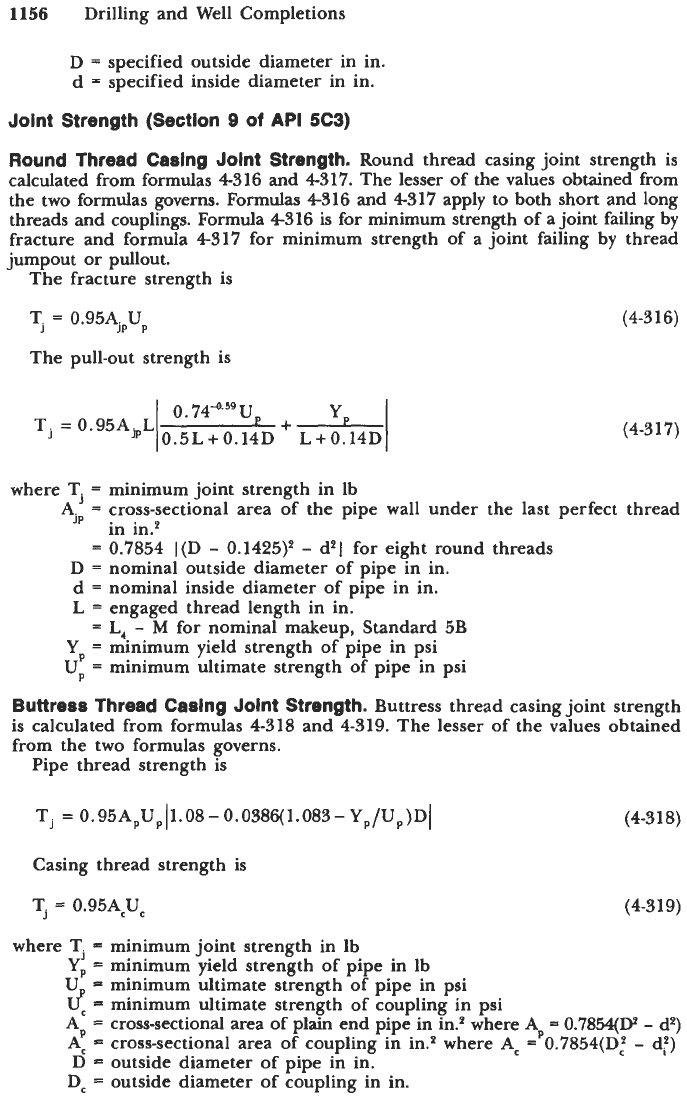
1156
Drilling and Well Completions
D
=
specified outside diameter in in.
d
=
specified inside diameter in in.
Joint Strength (Section
9
of
API
5C3)
Round Thread Casing Joint Strength.
Round thread casing joint strength is
calculated from formulas
4316
and
4317.
The lesser of the values obtained from
the two formulas governs. Formulas
4316
and
4317
apply to both short and long
threads and couplings. Formula
4316
is for minimum strength of a joint failing by
fracture and formula
4317
for minimum strength of a joint failing by thread
jumpout or pullout.
The fracture strength is
T,
=
0.95AjpUp
The pull-out strength is
yp
I
+
0.744.59U,
T,
=
0.95A,L
0.5L+0.14D L+0.14D
(4-3 16)
(4-3
17)
where T,
=
minimum joint strength in lb
A,,
=
cross-sectional area of the pipe wall under the last perfect thread
in in.2
=
0.7854 I(D
-
0.1425)*
-
dpl for eight round threads
D
=
nominal outside diameter of pipe in in.
d
=
nominal inside diameter of pipe in in.
L
=
engaged thread length in in.
=
L,
-
M
for nominal makeup, Standard
5B
Y,
=
minimum yield strength of pipe in psi
Up
=
minimum ultimate strength of pipe in psi
Buttress Thread Casing Joint Strength.
Buttress thread casing joint strength
is calculated from formulas
4-318
and
4-319.
The lesser of the values obtained
from the two formulas governs.
Pipe thread strength is
T,
=
0.95ApU,(1.O8-0.0386(1.083-
Y,/U,)D(
(4-3 18)
Casing thread strength is
T,
=
0.95AcU, (4-319)
where
T.
=
minimum joint strength in Ib
Yi
U
=
minimum ultimate strength of pipe in psi
u’,
=
minimum ultimate strength of coupling in psi
A
=
cross-sectional area of plain end pipe in in.p where
A,
-
0.7854(Ds
-
dp)
A:
=
cross-sectional area of coupling in in.4 where
Ac
=
0.7854(D:
-
d4)
D
=
outside diameter of pipe in in.
Dc
minimum yield strength of pipe in lb
outside diameter of coupling in in.
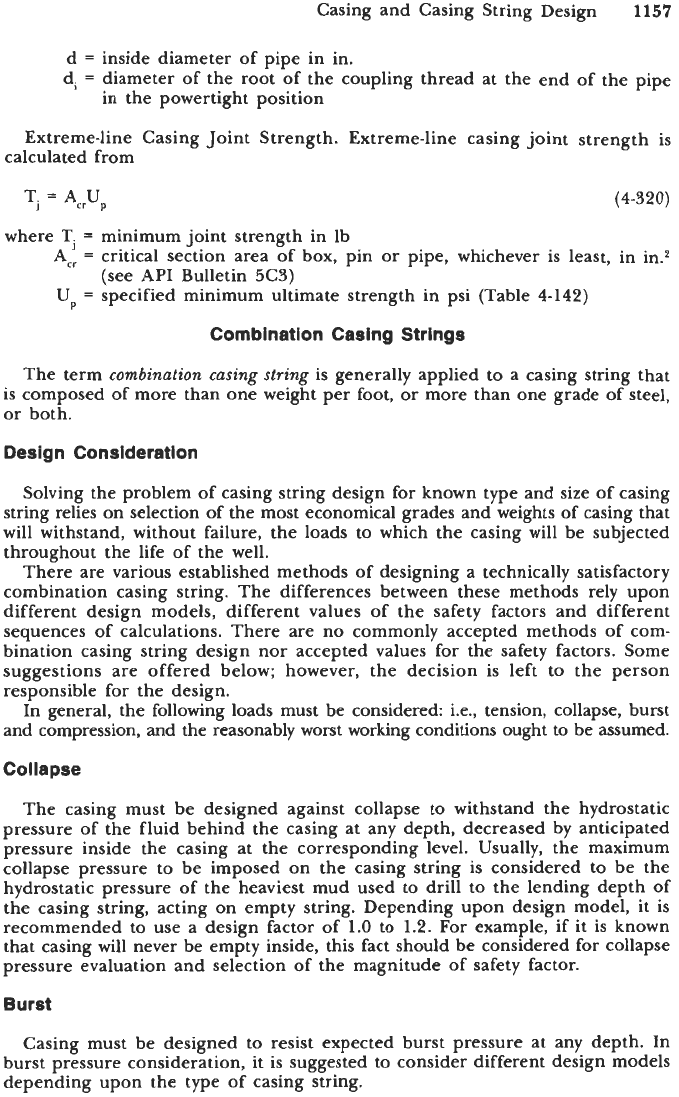
Casing and Casing String Design
1157
d
=
inside diameter of pipe in in.
d,
=
diameter of the root of the coupling thread at the end of the pipe
in the powertight position
Extreme-line Casing Joint Strength. Extreme-line casing joint strength is
calculated from
Tj
=
AcrUp
(4-320)
where Tj
=
minimum joint strength in lb
Acr
=
critical section area of box, pin
or
pipe, whichever is least, in in.2
Up
=
specified minimum ultimate strength in psi (Table
4-142)
(see
API
Bulletin
5C3)
Combination Casing Strings
The term
combination casing string
is generally applied to a casing string that
is composed of more than one weight per foot, or more than one grade of steel,
or
both.
Design Consideration
Solving the problem
of
casing string design for known type and size of casing
string relies on selection
of
the most economical grades and weights of casing that
will withstand, without failure, the loads to which the casing will be subjected
throughout the life of the well.
There are various established methods of designing a technically satisfactory
combination casing string. The differences between these methods rely upon
different design models, different values
of
the safety factors and different
sequences of calculations. There are no commonly accepted methods of com-
bination casing string design nor accepted values for the safety factors. Some
suggestions are offered below; however, the decision is left to the person
responsible for the design.
In
general, the following loads must be considered: i.e., tension, collapse, burst
and compression,
and
the reasonably worst working conditions ought
to
be assumed.
Collapse
The casing must be designed against collapse to withstand the hydrostatic
pressure of the fluid behind the casing at any depth, decreased by anticipated
pressure inside the casing at the corresponding level. Usually, the maximum
collapse pressure
to
be imposed on the casing string is considered to be the
hydrostatic pressure of the heaviest mud used to drill to the lending depth of
the casing string, acting on empty string. Depending upon design model, it is
recommended to use a design factor of
1.0
to
1.2.
For example, if it is known
that casing will never be empty inside, this fact should be considered for collapse
pressure evaluation and selection of the magnitude of safety factor.
Burst
Casing must be designed to resist expected burst pressure
at
any depth. In
burst pressure consideration, it is suggested to consider different design models
depending upon the type of casing string.
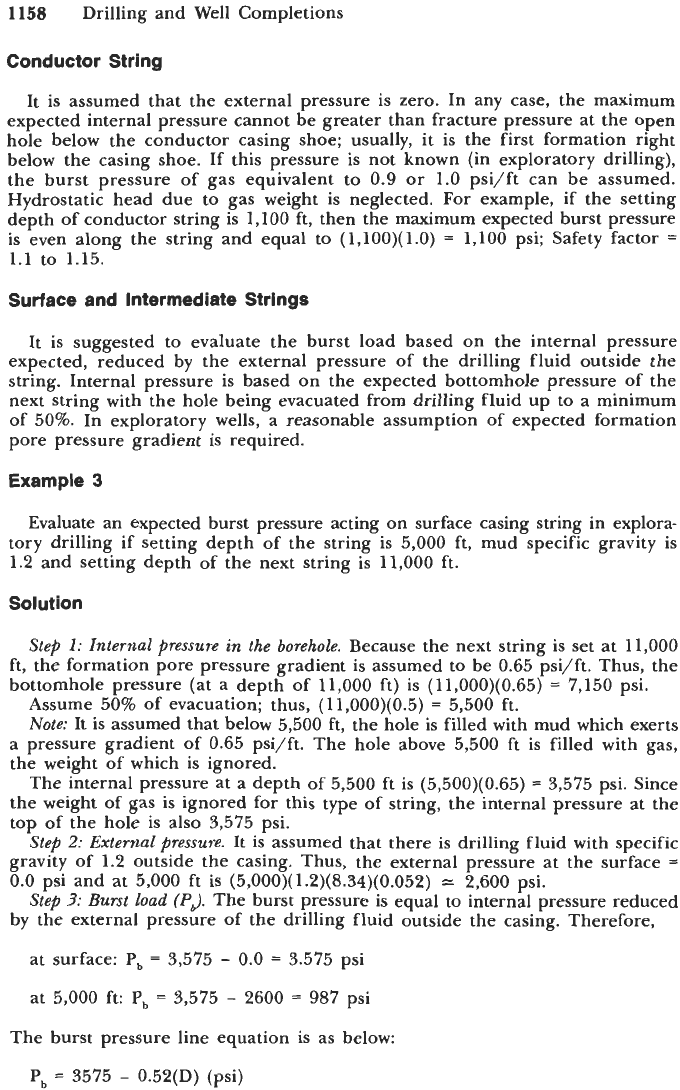
1158
Drilling and Well Completions
Conductor String
It is assumed that the external pressure is zero. In any case, the maximum
expected internal pressure cannot be greater than fracture pressure at the open
hole below the conductor casing shoe; usually, it is the first formation right
below the casing shoe. If this pressure is not known (in exploratory drilling),
the burst pressure of gas equivalent to 0.9 or 1.0 psi/ft can be assumed.
Hydrostatic head due to gas weight is neglected. For example, if the setting
depth of conductor string is 1,100 ft, then the maximum expected burst pressure
is even along the string and equal to (l,lOO)(l.O)
=
1,100 psi; Safety factor
=
1.1 to 1.15.
Surface and Intermediate
Strings
It
is
suggested to evaluate the burst load based on the internal pressure
expected, reduced by the external pressure of the drilling fluid outside the
string. Internal pressure is based on the expected bottomhole pressure of the
next string with the hole being evacuated from drilling fluid up to a minimum
of 50%. In exploratory wells, a reasonable assumption of expected formation
pore pressure gradient is required.
Example
3
Evaluate an expected burst pressure acting on surface casing string in explora-
tory drilling if setting depth of the string is 5,000 ft, mud specific gravity is
1.2 and setting depth of the next string is
11,000
ft.
Solution
Step
1:
Internal pressure in the borehole.
Because the next string is set at 11,000
ft, the formation pore pressure gradient is assumed to be 0.65 psi/ft. Thus, the
bottomhole pressure (at a depth of 11,000
ft)
is (11,000)(0.65)
=
7,150 psi.
Assume 50% of evacuation; thus, (1 1,000)(0.5)
=
5,500 ft.
Note:
It
is
assumed that below 5,500 ft, the hole
is
filled with mud which exerts
a pressure gradient of 0.65 psi/ft. The hole above 5,500
ft
is filled with gas,
the weight of which is ignored.
The internal pressure at a depth of 5,500
ft
is (5,500)(0.65)
=
3,575 psi. Since
the weight of gas is ignored for this type of string, the internal pressure at the
top of the hole is also 3,575 psi.
Step
2:
External pressure.
It is assumed that there is drilling fluid with specific
gravity of 1.2 outside the casing. Thus, the external pressure at the surface
=
0.0
psi and at 5,000 ft is
(5,000)(1.2)(8.34)(0.052)
=
2,600 psi.
Step
3:
Burst Goad
(PJ.
The burst pressure is equal to internal pressure reduced
by the external pressure of the drilling fluid outside the casing. Therefore,
at surface:
P,
=
3,575
-
0.0
=
3.575 psi
at 5,000 ft:
P,
=
3,575
-
2600
=
987 psi
The burst pressure line equation is as below:
P,
=
3575
-
0.52(D) (psi)
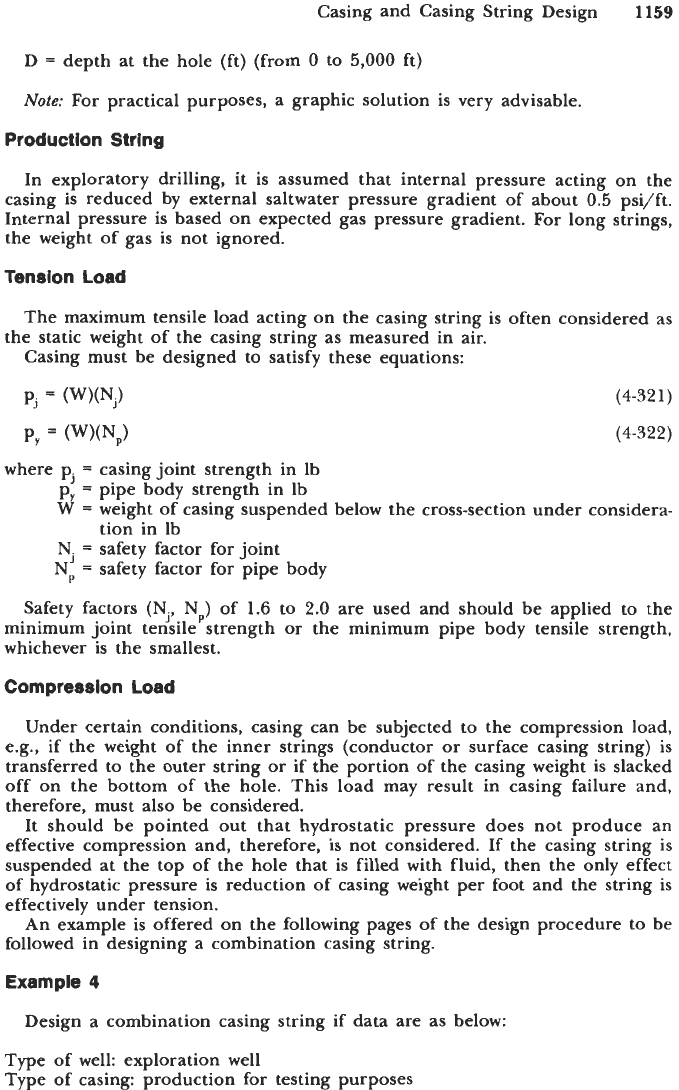
Casing and Casing String Design
1159
D
=
depth at the hole (ft) (from
0
to
5,000
ft)
Note:
For practical purposes, a graphic solution is very advisable.
Production String
In exploratory drilling, it is assumed that internal pressure acting on the
casing is reduced by external saltwater pressure gradient of about
0.5
psi/ft.
Internal pressure is based on expected gas pressure gradient. For long strings,
the weight of gas is not ignored.
Tension Load
The maximum tensile load acting on the casing string is often considered as
the static weight of the casing string
as
measured in air.
Casing must be designed to satisfy these equations:
(4-321)
(4-322)
where pj
=
casing joint strength in lb
py
=
pipe
body strength in Ib
W
=
weight of casing suspended below the cross-section under considera-
Nj
=
safety factor for joint
NP
=
safety factor for pipe body
tion in Ib
Safety factors
(Nj,
NP)
of
1.6
to
2.0
are used and should be applied
to
the
minimum joint tensile strength or the minimum pipe body tensile strength,
whichever is the smallest.
Compression Load
Under certain conditions, casing can be subjected to the compression load,
e.g., if the weight of the inner strings (conductor or surface casing string) is
transferred
to
the outer string
or
if the portion
of
the casing weight is slacked
off on the bottom of the hole. This load may result in casing failure and,
therefore, must also be considered.
It should be pointed out that hydrostatic pressure does not produce an
effective compression and, therefore, is
not
considered. If the casing string is
suspended at the top of the hole that is filled with fluid, then the only effect
of hydrostatic pressure is reduction of casing weight per foot and the string is
effectively under tension.
An example is offered on the following pages of the design procedure to be
followed in designing a combination casing string.
Example
4
Design
a
combination casing string if data are as below:
Type of well: exploration well
Type of casing: production for testing purposes
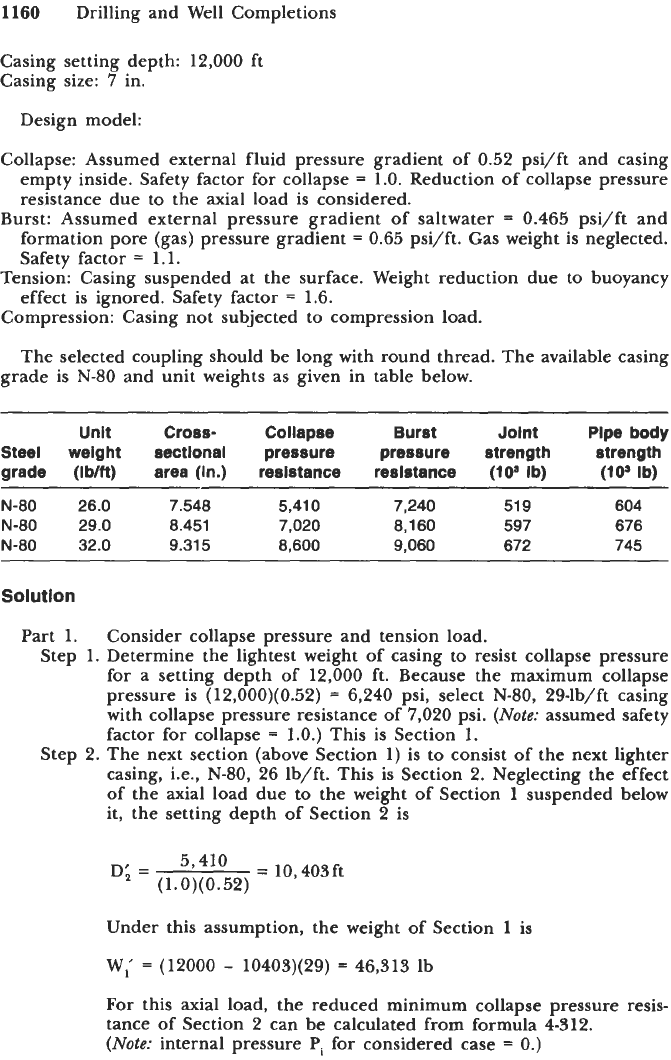
1160
Drilling and Well Completions
Casing setting depth: 12,000 ft
Casing size:
7
in.
Design model:
Collapse: Assumed external fluid pressure gradient of
0.52
psi/ft and casing
empty inside. Safety factor for collapse
=
1.0. Reduction of collapse pressure
resistance due to the axial load is considered.
Burst: Assumed external pressure gradient of saltwater
=
0.465 psi/ft and
formation pore (gas) pressure gradient
=
0.65 psi/ft. Gas weight is neglected.
Safety factor
=
1.1.
Tension: Casing suspended at the surface. Weight reduction due to buoyancy
effect is ignored. Safety factor
=
1.6.
Compression: Casing not subjected to compression load.
The selected coupling should be long with round thread. The available casing
grade is
N-80
and unit weights as given in table below.
Unit Cross- Collapse Burst Jolnt Plpe body
Steel weight sectlonal pressure pressure strength strength
grade (Iblft) area (In.) resistance resistance
(10’
Ib)
(lo5
Ib)
~ ~ ~~ ~~~~~~~~~~~
N-80 26.0 7.548 5,410
7,240
51
9
604
N-80 29.0
8.451 7,020
8,160 597 676
N-80
32.0
9.315 8,600
9,060 672 745
Solution
Part 1. Consider collapse pressure and tension load.
Step
1.
Determine the lightest weight of casing to resist collapse pressure
for a setting depth of 12,000 ft. Because the maximum collapse
pressure is (12,000)(0.52)
=
6,240 psi, select N-80, 29-lb/ft casing
with collapse pressure resistance of
7,020
psi.
(Note:
assumed safety
factor for collapse
=
1.0.)
This is Section 1.
Step
2.
The next section (above Section 1) is to consist of the next lighter
casing, Le., N-80, 26 lb/ft. This is Section
2.
Neglecting the effect
of
the axial load due to the weight of Section 1 suspended below
it, the setting depth of Section
2
is
59
410
=
10,403ft
D’2
=
(1.0)(0.52)
Under this assumption, the weight of Section
1
is
W,’
=
(12000
-
10403)(29)
=
46,313 lb
For
this axial load, the reduced minimum collapse pressure resis-
tance of Section
2
can be calculated from formula 4-312.
(Note:
internal pressure Pi for considered case
=
0.)
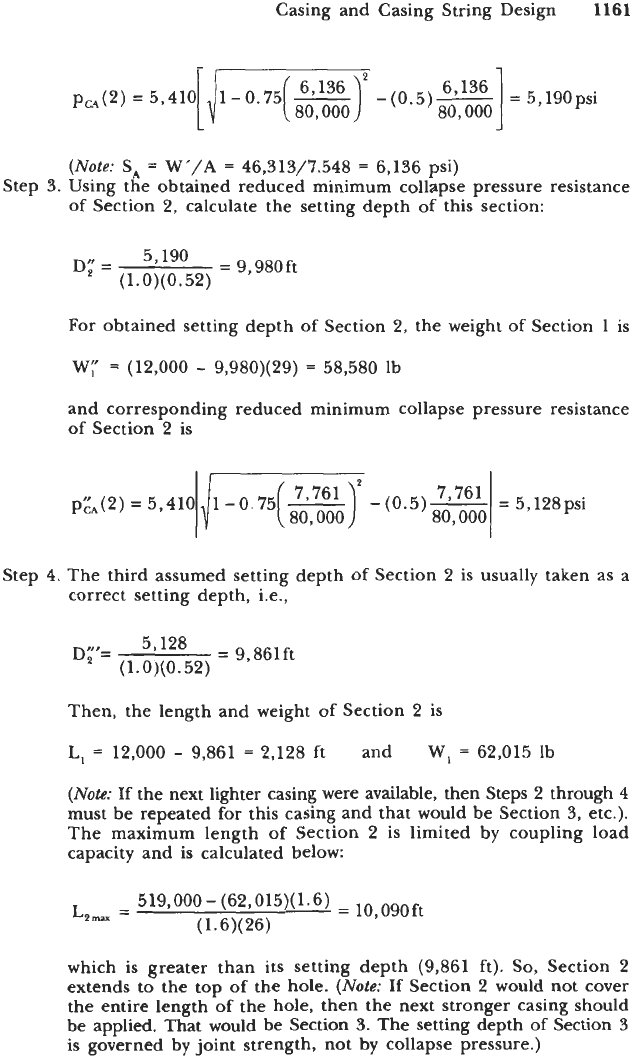
Casing
and
Casing String Design
1161
p,(2) = ,,,lo[
(Note:
SA
=
W’/A
=
46,313/7.548
=
6,136 psi)
of Section 2, calculate the setting depth of this section:
Step
3.
Using the obtained reduced minimum collapse pressure resistance
D;=
5’190
=9,98Oft
(1.0)(0.52)
For
obtained setting depth of Section 2, the weight of Section 1 is
W;
-
(12,000
-
9,980)(29)
=
58,580 lb
and corresponding reduced minimum collapse pressure resistance
of Section 2 is
7
761
I
pL(2)
=
5,410 1-0.75
-
-(0.5)-
=
5,128psi
80,000
80,000
Step 4. The third assumed setting depth
of
Section
2
is usually taken as a
correct setting depth, i.e.,
D”’=
5’128
=
9,861ft
*
(1.0)(0.52)
Then, the length and weight of Section 2 is
L,
=
12,000
-
9,861
=
2,128
ft
(Note:
If the next lighter casing were available, then Steps 2 through
4
must be repeated for this casing and that would be Section
3,
etc.).
The maximum length of Section 2 is limited by coupling load
capacity and is calculated below:
and
W,
=
62,015 lb
which
is
greater than its setting depth (9,861 ft).
So,
Section
2
extends to the top of the hole.
(Note:
If
Section
2
would not cover
the entire length
of
the hole, then the next stronger casing should
be applied. That
would
be Section
8.
The setting depth of Section 3
is governed by joint strength, not
by
collapse pressure.)
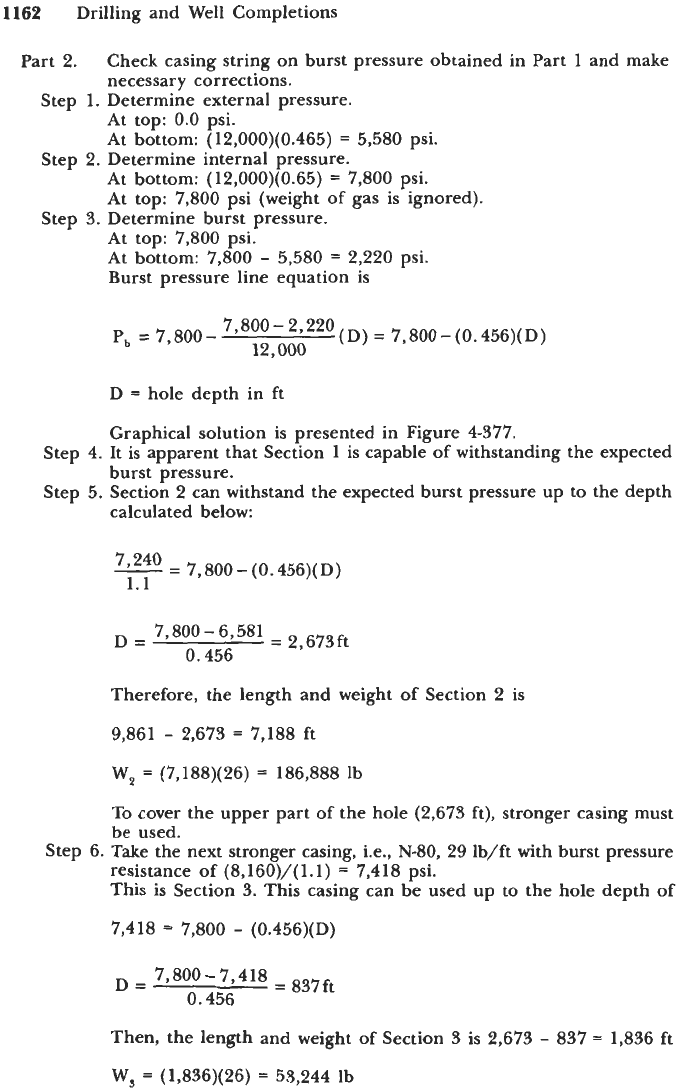
1162
Drilling and Well Completions
Part
2.
Check casing string on burst pressure obtained in Part
1
and make
necessary corrections.
Step
1.
Determine external pressure.
At top:
0.0
psi.
At bottom:
(12,000)(0.465)
=
5,580
psi.
At bottom:
(12,000)(0.65)
=
7,800
psi.
At top:
7,800
psi (weight of gas is ignored).
Step
3.
Determine burst pressure.
At top:
7,800
psi.
At bottom:
7,800
-
5,580
E
2,220
psi.
Burst pressure line equation is
Step
2.
Determine internal pressure.
P,
=
7,800-
7'800-27220
(D)
=
7,800
-
(0.456)(
D)
12,000
D
=
hole depth in ft
Graphical solution is presented in Figure
4-377.
burst pressure.
calculated below:
Step
4.
It is apparent that Section
1
is capable
of
withstanding the expected
Step
5.
Section
2
can
withstand the expected burst pressure up to the depth
-
7,240
=
7,800-(0.456)(D)
1.1
Therefore, the length
and
weight of Section
2
is
9,861
-
2,673
=
7,188
ft
W,
=
(7,188)(26)
=
186,888
lb
To cover the upper part of the hole
(2,673
ft), stronger casing must
be used.
Step
6.
Take the next stronger casing, i.e.,
N-80,
29
lb/ft with burst pressure
resistance of
(8,160)/(1.1)
-
7,418
psi.
This is Section
3.
This casing can be used up to the hole depth
of
7,418
=
7,800
-
(0.456)(D)
Then, the length and weight of Section
3
is
2,673
-
837
=
1,836
ft
W,
=
(1,836)(26)
=
53,244
lb
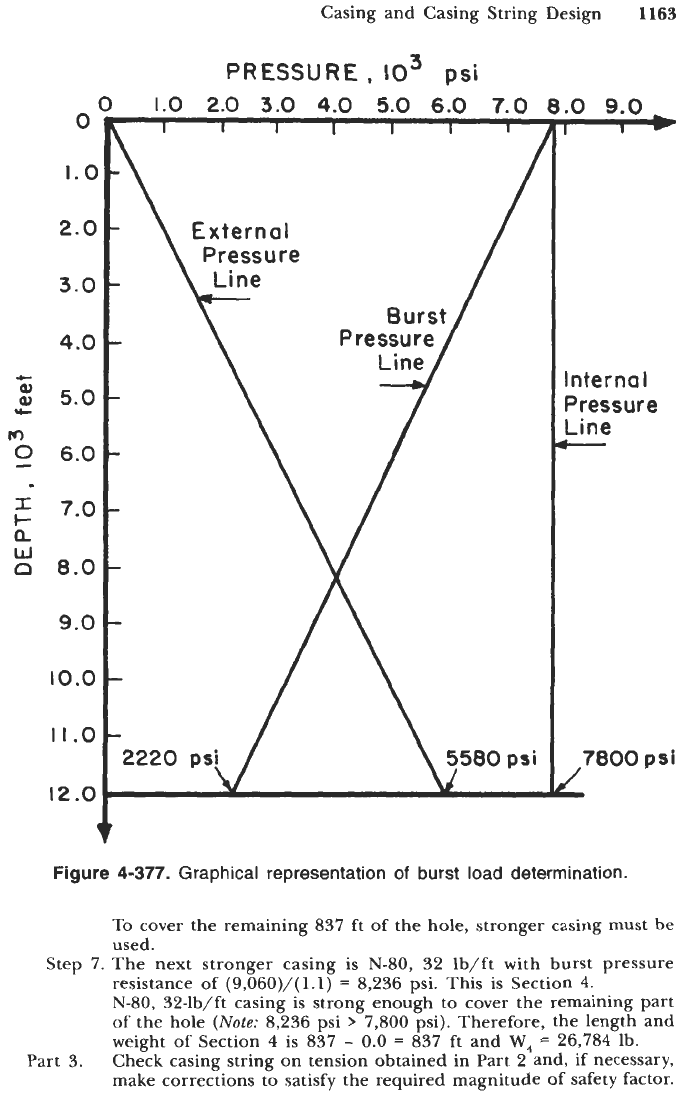
Casing and Casing String Design
1163
0
I.
0
2.0
3.0
4
.O
w
5.0
0
-
6.0
*
7.0
k
a
w
a
8.0
9.0
10.0
11.0
12.0
c
W
Y-
m
PRESSURE,
lo3
psi
1.0
2.0
3.0
4.0
5.0
6.0
7.0
Line
n
__
\
r
re
.o
9.0
v
Internal
Pressure
Line
-
II
/7800
psi
Figure
4-377.
Graphical representation
of
burst load determination.
To cover the remaining 837 ft of the hole, stronger casing must
be
used.
Step
7.
The next stronger casing is
N-80,
32 lb/ft with burst pressure
resistance of (9,060)/(1.1)
=
8,236 psi. This is Section
4.
N-80,
32-lb/ft casing is strong enough to cover the remaining part
of the hole
(Note:
8,236 psi
7,800
psi). Therefore, the length and
weight of Section
4
is
837
-
0.0
=
837 ft and
W,
=
26,784 lb.
Check casing string on tension obtained in Part 2 and, if necessary,
make corrections to satisfy the required magnitude of safety factor.
Part 3.
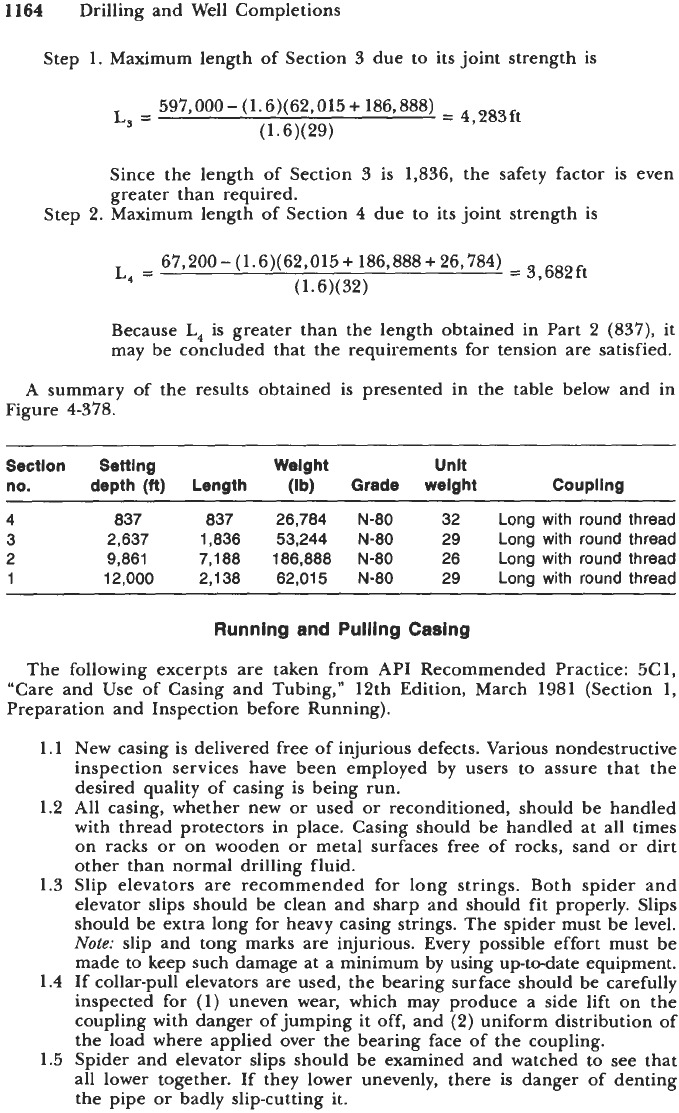
1164
Drilling and Well Completions
Step
1.
Maximum length of Section
3
due to its joint strength is
597,000
-
(1.6)(62,015
+
186,888)
=
4,283ft
L,
=
(1.6)(29)
Since the length of Section
3
is
1,836,
the safety factor is even
greater than required.
Step
2.
Maximum length of Section
4
due to its joint strength is
Because
L,
is greater than the length obtained in Part
2 (837),
it
may be concluded that the requirements for tension are satisfied.
A summary
of
the results obtained is presented in the table below and in
Figure
4-378.
~~ ~~ ~~ ~ ~
Section Setting Weight Unit
no.
depth
(ft)
Length (ib) Grade weight Coupilng
4 837
837 26,784
N-80 32
Long with round thread
3 2,637 1,836 53,244
N-80 29
Long with round thread
2
9,861 7,188 186,888 N-80 26
Long with round thread
1 12,000
2,138 62,015
N-80 29
Long with round thread
Running and Pulling Casing
The following excerpts are taken from API Recommended Practice:
5C1,
“Care and Use of Casing and Tubing,”
12th
Edition, March
1981
(Section
1,
Preparation and Inspection before Running).
1.1
New casing is delivered free of injurious defects. Various nondestructive
inspection services have been employed by users to assure that the
desired quality
of
casing
is
being run.
1.2
All casing, whether new
or
used
or
reconditioned, should be handled
with thread protectors in place. Casing should be handled at all times
on racks
or
on wooden
or
metal surfaces free of rocks, sand
or
dirt
other than normal drilling fluid.
1.3
Slip elevators are recommended for long strings. Both spider and
elevator slips should be clean and sharp and should fit properly. Slips
should be extra long for heavy casing strings. The spider must be level.
Note:
slip and tong marks are injurious. Every possible effort must be
made to keep such damage at a minimum by using up-to-date equipment.
1.4
If collar-pull elevators are used, the bearing surface should be carefully
inspected for
(1)
uneven wear, which may produce a side lift on the
coupling with danger of jumping it off, and
(2)
uniform distribution of
the load where applied over the bearing face of the coupling.
1.5
Spider and elevator slips should be examined and watched to see that
all lower together. If they lower unevenly, there is danger of denting
the pipe
or
badly slip-cutting
it.
